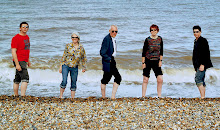Along the window by the street: 'A line around a shadow' is an assemblage of tallish, thin pots, catching changing light from the window, and reflected in it. Again, there are the marks of touching and - as with some in 'Predella' - adhesions that almost resemble wings, or as if they'd been suggested by a broken handle some time in the distant past.
Is it lese-majesté to wonder if de Waal ever worked as a waiter? That homely association of function hovers behind 'A Change in the Weather' (suggesting a dresser) and particularly 'Attic' and 'Wunderkammer' which also rely on our readings of domestic porcelain and how it is used and stored. Perhaps that's a sweeping statement, though I can't be unusual in seeing these associations.
'Wunderkammer' itself stands in the middle of the room, inviting and resisting our attention. This large plywood cabinet, smelling strongly of the plaster and resin in its construction, is stacked like a pantry inside with white plates and dishes, observable on their shelves above and below through narrow vertical and horizontal slits. Again, the placing seems random, but nothing is ever really random with de Waal. One of the horizontal windows was too high for me, probably too high for most people, remaining merely a teasing possibility. The idea comes slowly: how did they get in there, how do you get them out, which bit did he finish last? But then again, the idea of sequestration, collection, order, interiority... When we look through the slits, are we spying on the plates, or are we being permitted a glimpse? They are blameless. The plates are candid, literally.
There are dishes that look like stacked ashtrays, but it's inconceivable that someone as ascetic as de Waal would smoke. There is order, discipline, control - yet the individuality of the plates. These are protestant plates. And our access to them is controlled, orchestrated. We are required to see them in a certain light.
The components aren't objects for possession. Their function is as part of a whole, as part of an installation. It is public art, not rich man's art - or so I thought. Wunderkammer is for sale at £180,000.
And while we're contemplating this, friends of E's wander in and we are distracted. They start talking of house prices, and it feels incongruous while there are these abstract lares and penates all round us.
And back at the entrance, in the catalogue I find a piece I don't recall seeing: 'All you can see', which is described as pots on a red shelf. I don't recall any red shelf. I'd have noticed. So we go back and look, and while I'm detained once again by the exhibits, and wondering what it means, and what 'meaning' is in art anyway - E has found 'All you can see' and is laughing, because there it is: 5 metres up on the wall as you enter the Wunderkammer room, where you can't see it as you go in, and wouldn't have seeen it on your way out if you'd been talking to friends... So it's witty, as the red is bright poster paint red, and you can hardly see the pots way back from the edges of the shelf, almost out of sight, mocking us with their red shelf, the one strident note in the exhibition (after the slightly vulgar gold dabs).
Later, I read how de Waal has no compunction about smashing something he considers imperfect, that that's what porcelain is for, that archaeologists are always uncovering sherds.
Subscribe to:
Post Comments (Atom)



No comments:
Post a Comment